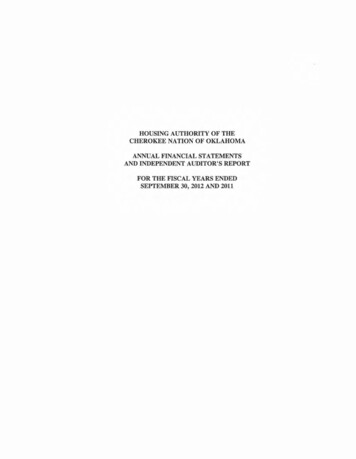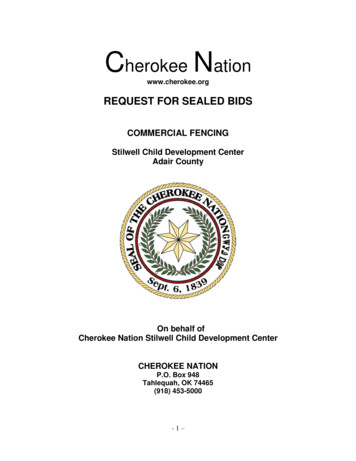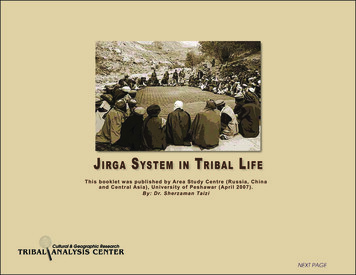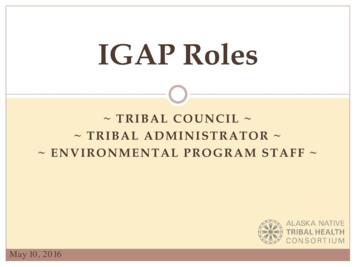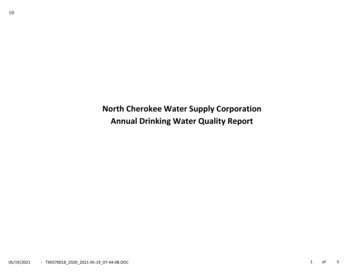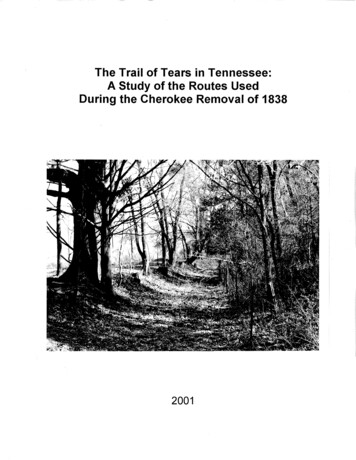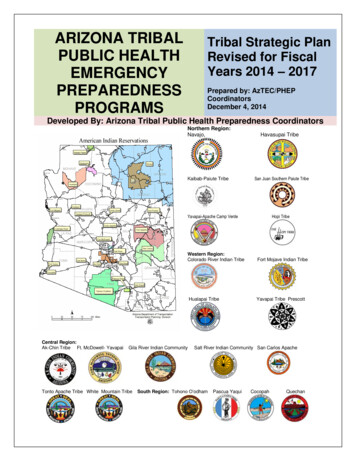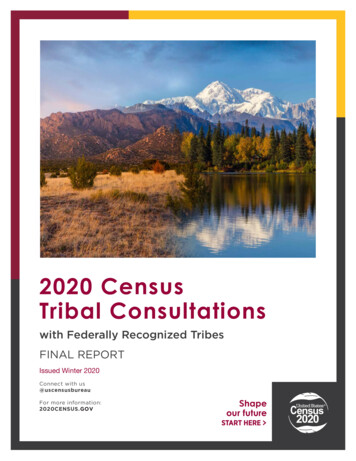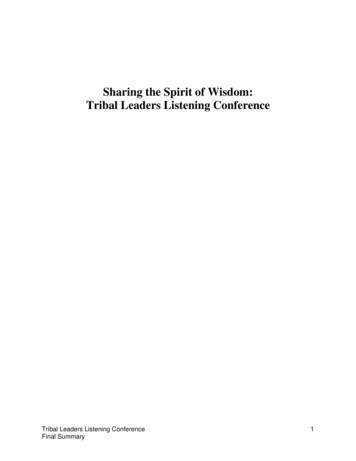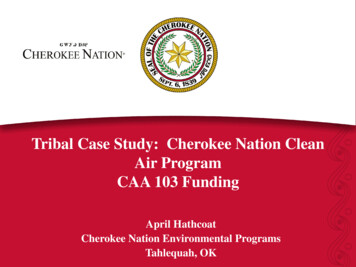
Transcription
Tribal Case Study: Cherokee Nation CleanAir ProgramCAA 103 FundingApril HathcoatCherokee Nation Environmental ProgramsTahlequah, OK
Cherokee Nation has385,000 citizens,with 143,706 livingwithin the CNreservation (as of June2020) The Cherokee Nationreservation iscomprised of 14counties innortheasternOklahoma (six fulland eight partialcounties) Total area of 6,950square miles
Largest tribaloutpatient healthfacility in U.S.opening firstphase to patientsThe Cherokee Nation is committed to protecting our inherent sovereignty, preservingand promoting Cherokee culture, language and values, and improving the quality oflife for the next seven generations of Cherokee Nation citizens.
CNEP OfficeThe Secretary of Natural Resources provides oversight to Cherokee NationEnvironmental Programs (CNEP). CNEP administers a variety of programs andservices related to the preservation and conservation of our air, land, water, andanimal & plant life. GAP Brownfields Clean Air Clean Water 106 UST Solid Waste Superfund Radon ASTM site assessment – Phase I NEPA Pesticides Lead-based Paint Inspection/Certification“To protect, preserve and restore in a sustainable manner our Nation’s naturallydiverse ecosystems for the health and benefit of future generations.”
An Overview of the CherokeeNation Clean Air Program The Clean Air Program began in 1996 with a §103 project grant. Cherokee Nation received treatment in the same manner as a state undersection 301(d) of the Clean Air Act in 2009. TAS was granted for purposes of grant funding at a reduced matching shareunder section 105 and notice and opportunity to comment on proposedmajor source air operating permits as an “affected state” under section505(a)(2).
An Overview of the CherokeeNation Clean Air Program The network consists of five monitoring stations – four fixed locations andone mobile monitoring station All stations monitor ozone and meteorological parameters; a few monitorother pollutants, such as CO, SO2, NO2 and particulate matter. The Cherokee Nation participates in four EPA national programinitiatives: Clean Air Status and Trends Network (CASTNET) – evaluateslong-term trends in ambient concentrations and dry depositionestimates
An Overview of the CherokeeNation Clean Air Program Interagency Monitoring of Protected Visual Environments(IMPROVE) – tracks changes in visibility Mercury Deposition Network (MDN) – measures mercury inprecipitation Ammonia Monitoring Network (AMoN) – measures ammonia gasconcentrations via passive samplingThe Cherokee Nation has also established an NCore site at its rural CASTNetsite near Stilwell.
Inter-Tribal Environmental Council ITECconsortium formed in October 1992 20 Tribes ITECsigned the original MOUcurrently provides services to 45Tribes and Pueblos in Oklahoma, NewMexico, Texas, and Louisiana.
https://itec.cherokee.org/“To protect the health of Native Americans, their natural resources,and their environment as it relates to air, land, and water.”
How does the air programparticipate? Baselineassessments Technical assistance Air Quality System (AQS) data entry support
Mobile monitorThe CNEP operators a mobile monitor for use by tribes in Region 6. Mobileparameters monitored include: Ozone PM10 & PM2.5 (TEOM 1405-D) Met (Temperature, RH, WS & WD)
The mobile monitor hasbeen operational since2006. Data from the monitor isuploaded hourly intoAirNow. Data is entered into AQSquarterly (nonregulatory). The station is typicallydeployed at each site forone year.
The current monitoring location is with the Muscogee(Creek) Nation – since July 2020
Independent Auditing Services Clean AirStaff provides independent auditingservices using certified equipment andstandards. Theseservices are provided to participatingtribes at no cost. TheITEC Clean Air Staff is currently performsaudits for the Quapaw Nation and Kaw Nation.
We have tasks in our air grantspecifically for ITEC-related work;the air program does not use anyGAP funds.
Programmatic responsibilities Submit grant applicationSubmit purchase orders for new fiscal yearSubmit QAPP (every two years or if significant changes)QMP (every year, one for CNEP office)SOPsLevel I checks (every two weeks, mobile every month)Quarterly checks/maintenanceCertifying standards (every year)Certifying ozone primary standard every year (every year)Verifying transfer standards (every quarter)Independent audits (every quarter)AQS submittal: raw data, QA data, zero/span (every quarter)Data certification (annually)Quarterly reportsMonthly reports (internal)Consumable inventoryGas cylinder inventoryAnd everyone’s favorite, “other duties as assigned”.
Developing our grant proposal Who is involved? I am the primary author, but I depend on my team to provide an estimate ofsupplies, as well as what new equipment we may potentially need We have a Grants Development team that must review all applications and theysubmit the application via grants.gov Length of time Because our application must be reviewed by Grants Development, we must haveeverything completed a couple of weeks before it is due to EPA I could probably complete in a week if that’s all I was doing, but let’s be realistic Research? I keep an ongoing file on the public drive Grants Development provides updated IDC and fringe rates and demographics Get updated quotes for supplies and as well as quotes for equipment (for anestimate only, we still have to go through the bid process if over 5,000)
Developing our grant proposal Share drafts with TAC? Will ask some general questions In Region 6, we submit proposal first and then negotiate from there for the finalgrant submittal How do we ensure we meet our deliverables? Be realistic! Allow time for training if you are new to air Allow time for paperwork (AQS setup, ordering equipment, etc.) Be aware of due dates (data submittal, data certification, QAPPs, etc.)Give yourself time to manage your data! There is a lot involved, but there are alsosome great resources for assistance (TAMS Center, ITEP training, other http://www7.nau.edu/itep/main/tams/Tools/tools aqshttps://www7.nau.edu/itep/main/Resources/res aq
Grant funding – 103 versus 105 103 – no match required 105 –The tribes approved for awards under Section 105 arerequired to provide a minimum 40% match unless approved fortreatment in a manner similar to a state (TAS), in which case areduced match of 5% is required for the first two years of funding.If funding continues after two years, then the required match israised to 10%. The required match may be waived (0%) if a tribesuccessfully demonstrates financial hardship [40 CFR 35.575(a)]. Only a 105 can be rolled into a PPG
Advice for other tribes usingfunds to develop an air programWhat are some of our challenges that you may face as well? Fringe rate doesn’t reflect “true” fringe rateIDC rate always changes after we receive our awardMake sure bonuses are reflecting in hourly rateHow do we determine what equipment may need to be replaced?When to repair and when to replace equipmentNeed to have a plan for attrition (this is a big one)Citizens request sampling that we cannot provide
Advice for other tribes usingfunds to develop an air program Funding sources – there may be additional sources other than 103/105(Exchange Network, Community Air Toxics Monitoring, nt-monitoring-csatam Check out equipment loans from the TAMS Center so you can get someexperience using monitors May consider starting with an emission inventory (EI) first Write detailed SOPs and keep them updated! Take good notes and keep your project officer informed of any changes!
Your Tribe may go with a different approach Data management – Proprietary software, free software (Tribal DataToolbox!) Data analysis – you may work very closely with yourepidemiologist/health services, or you may do forecasting for burns, etc. Outreach – may be much more personalized Emission Inventory - may be confined to your reservation and muchmore thorough, or you may have an interest in a particular source (mining,etc.) Tribal Implementation Plan (TIP) - you may be interested inenforcement and permitting
What 2-3 factors contribute to our program’s success?The top two!Also, we get a lot of support from the CNEP office and ourSecretary of Natural Resources, as well as the EnvironmentalProtection Commission (EPC).
goals? How do we best maintain what we have? Seriously look at creating a tech position Is there a new location where regulatory monitoringmay be warranted? Can we make our data morepublicly accessible/useable?
Contact information:April Air-Program
An Overview of the Cherokee Nation Clean Air Program The Clean Air Program began in 1996 with a §103 project grant. Cherokee Nation received treatment in the same manner as a state under section 301(d) of the Clean Air Act in 2009. TAS was granted for purposes of grant funding at a reduced matching share

